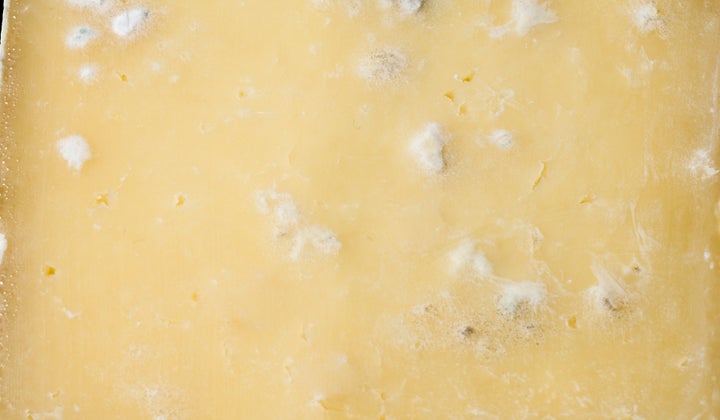
There is nothing more destructive to the human soul than coming home to what you know is a fully-stocked fridge, only to realise that the food you wanted has gone off.
For me, it’s usually bread (petition to make loaves more one person-friendly, please). But yesterday, I noticed a small, dusty ring of teal fur edged with white on my Parmesan ― and being honest, I just grated around that part and kept my meal prep pushing.
Obviously, I’m still here to type this story, and I already knew that lots of cheeses have mould in them naturally anyway. But should I have been so flippant? Here’s what the experts say:
Depends on the cheese, depends on the mould
Hard cheeses have a low moisture content (incidentally, that also makes them lower lactose, which is why I love them). So any mould that grows on them isn’t likely to spread to other parts of the cheese; your Parmesan, cheddar, Pecorino, and Swiss likely just needs a trim.
“To salvage [hard cheeses], trim at least 1 inch (2.5 cm) around [the mould] and below the mould,” Healthline shared. So, my strategy was more or less right (phew).
But if I’d have taken the same approach with a softer, watery cheese, I could have accidentally chowed down on some potentially dangerous spores. They spread far more easily across grated, spreadable, pre-sliced, or crumbly cheeses.
“Any signs of mould on these kinds, which include cream cheese, cottage cheese, and ricotta, mean that it should be thrown out at once — as the spores can easily contaminate the entire product,” Healthline say.
Of course, you should avoid eating mould on even hard cheeses, so if the patch is taking up most of your Parm wedge, bin it as you need to carve at least an inch away from the sporees. And if you’re not sure about whether or not your food is too mouldy to eat, it’s always better to leave it.
Mould can cause food poisoning
You can get everything from E.coli to Salmonella from the mould that grows on cheese, so storage and smart buying is essential.
Try to avoid buying cheeses with atypical signs of mould, yellowing, or hardness. Store them in tightly-wrapped plastic or even airtight containers to limit the amount of oxygen they’re exposed to.
“Always double-wrap your cheese – in waxed paper or baking parchment, ideally – and put it in a plastic container lined with dampened kitchen towel or J-cloth,” Patricia Michelson, owner of La Fromagerie in London, shared with The Guardian.
You should place your cheese on the top shelf of your fridge, experts say, as this offers the most stable temps. This should help to keep the mould at bay (and make all of our weeknight cooking sessions a little less stressful).